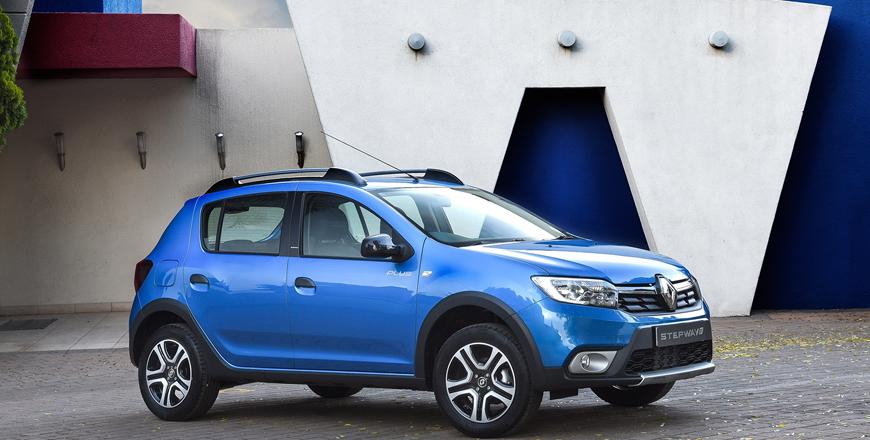You are here
Renault Stepway 1.6L: Taking on the urban jungle
By Ghaith Madadha - Jul 12,2021 - Last updated at Jul 12,2021

Photo courtesy of Renault
A small, affordable, economical and tough yet comfortable compact urban crossover, the Renault Stepway is an ideal and uncomplicated daily driver engineered with developing markets in mind. A rebadged version of Renault’s Romanian subsidiary Dacia’s high riding Sandero Stepway and its base hatchback sister, the Renault version is virtually indistinguishable bar the French manufacturer’s iconic diamond-like badge.
Introduced in its first generation in 2008, the Stepway is already in its third generation for some markets, but others, including Jordan, the second-generation model is still going strong.
Wide stance compact
A junior sister model to Renault’s and Dacia’s popular Duster crossover, with a more distinctly urban appeal and less emphasis on off-road ability, the second generation Stepway was first launched at the 2012 Paris Motor Show. A smaller proposition than the Duster, the Stepway is noticeably shorter and more condensed in design. Compact and road-oriented as it may be, the Stepway nevertheless has a rugged SUV-like appeal owing to the black cladding along its lower wheel-arches and sills, faux front skid plate and roof rails.
With similar width and height, and short wheelbase and rear overhang, the Stepway looks as agile and manoeuvrable as it is on the road, and seems to sit on the road with a greater sense of width than its demure dimensions suggest. With its lower cladding, subtly pronounced wheel-arches, broad bonnet and browed grille and headlights, the Stepway’s sense of width is further accentuated, despite compact actual proportions. Meanwhile, the Stepway features discretely bulging rear haunches and an arcing roofline tapering to a concise rear treatment.
A step-up successor
Offered in European markets with a selection of smaller engines, including turbo-diesels and three-cylinder turbo petrol options under the Dacia brand, the Renault Stepway is instead powered by a less complicated and more powerful 1.6-litre naturally-aspirated four-cylinder engine driving the front wheels. A better breathing engine with double overhead camshafts and 16-valves compared to the 8-valve first generation Stepway previously featured in these pages, the current model gains 20BHP and 25lb/ft over its predecessor, and is livelier, more confident and versatile on road for it.
A compact and comparative lightweight at an estimated 1,140kg, the Stepway develops 110BHP at 5,750rpm and 109lb/ft at 3,750rpm, which allows decent estimated headline performance figures including 11-seconds 0-100km/h acceleration and a 170km/h top speed. Confident and responsive to throttle input from standstill, the Stepway is progressive through revs and in power and torque delivery. Meanwhile, its engine is eager to its rev limit, and its CVT transmission is more willing to allow this, despite being biased to maintaining more efficient revs, as CVT systems are.
Playful yet predictable
A more eager drive than its predecessor, the Stepway’s CVT may lack the driver control of a manual or even automatic gearbox. However, its “slingshot” style of operation as speed build up while ratios seamlessly alter and revs are held in a high torque range lends the Stepway what seems like a more versatile and confident mid-range for overtaking and incline. Driving the front wheels, the Stepway meanwhile feels more predictable and eager through corners than with the added weight of a front-biased all-wheel-drive system.
Smooth and stable on road for its compact crossover class, the Stepway drives much like a keen and light front-drive hatchback through corners, despite sitting higher off the ground than the regular Dacia Sandero hatchback it is based on. Turning tidily into and leaning slightly through corners, the Stepway’s wide track lends good stability. Meanwhile, the lack of sudden power diversion to the rear makes the Stepway predictable and consistent in road-holding, and with its light weight and small wheelbase, it is agile and adjustable through corners.
Well-packaged and practical
Refined for its segment, the Stepway is comfortable and settled over most imperfections, with its modest 205/55R16 tyres providing good absorption, durability and help with steering feel. A decidedly urban-oriented crossover, the Stepway should be capable of better than expected but moderate off-road ability, if past experience with other front-drive Renault-Dacia vehicles is to go by. With front-drive, short wheelbase and overhangs, low weight and usefully high 173mm ground clearance the Stepway would be expected to make short work of many dry, unpaved dirt roads.
Tall, compact and with a relatively big glasshouse, the Stepway is well-packaged with good visibility and is pleasant but unpretentious inside, with large uncomplicated controls, buttons and instrumentation, and seems well put together. Driving position is good and accommodates taller drivers, while rear space is decent for its class. Well equipped with useful mod cons, safety and infotainment features, if not advanced high tech equipment, the Stepway meanwhile provides easy boot access and 320-litre volume, which expands to 1,200-litres with its 60/40 split rear seats folded down.
TECHNICAL SPECIFICATIONS
Engine: 1.6-litre, transverse 4-cylinders
Compression ratio: 10.7:1
Valve-train: 16-valve, DOHC
Gearbox: Continuously variable transmission (CVT) auto, front-wheel-drive
Power, BHP (PS) [kW]: 110 (111) [81] @5,750rpm
Specific power: 68.8BHP/litre
Torque, lb/ft (Nm): 109 (148) @3,750rpm
Specific torque: 92.6Nm/litre
0-100km/h: approximately 11-seconds (estimate)
Top speed: approximately 170km/h (estimate)
Fuel capacity: 50-litres
Length: 4,089mm
Width: 1,761mm
Height: 1,555mm
Wheelbase: 2,589mm
Track, F/R: 1,489/1,492mm
Overhang, F/R: 846/654mm
Weight: 1,140kg (estimate)
Ground clearance: 173mm
Headroom, F/R: 900/881mm
Shoulder room, F/R: 1,387/1,393mm
Loading height: 793mm
Cargo volume, min/max: 320-/1,200-litres
Suspension, F/R: MacPherson struts/torsion beam
Steering: Power-assisted rack and pinion
Brakes, F/R: Ventilated discs/drums
Tyres: 205/55R16
Related Articles
Developed by and sold under Renault’s Romanian Dacia subsidiary in European markets and marketed as the Renault Symbol in some international
Hardly the first affordable and compact yet capable SUV, the Renault Duster nevertheless proved hugely popular in world markets, since it fi
The smallest and most affordable of Chinese state-owned auto manufacturer Chery’s crossover SUV line-up, the Tiggo 2 is a fairly equipped, c














